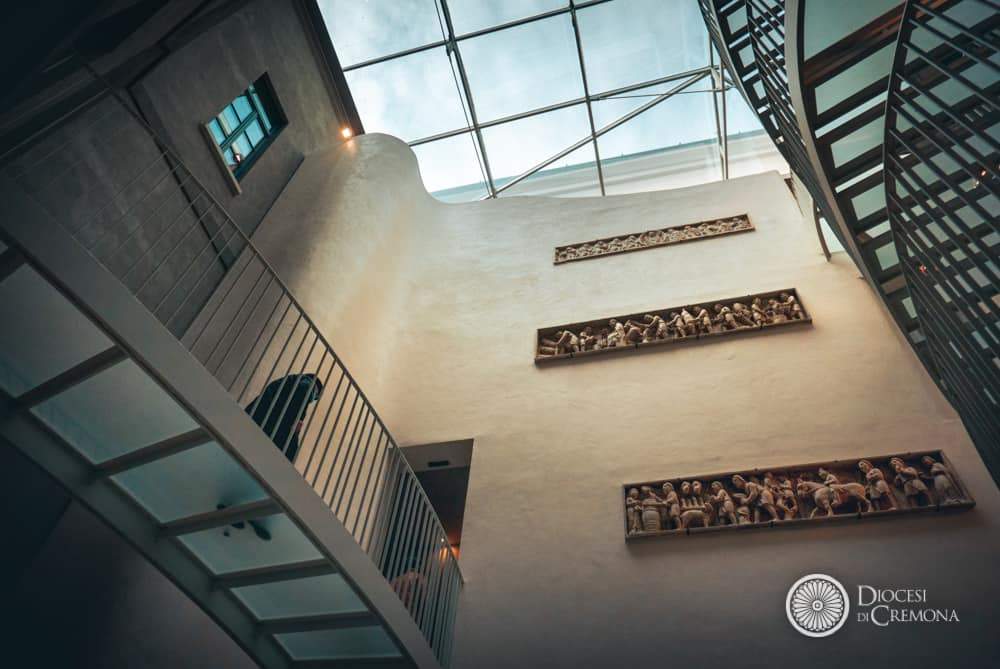A new museum opens, the Diocesan Museum of Cremona, near the cathedral and the Torrazzo
It is set for Saturday, November 13, on the feast of the patron saint St. Homobono, the opening of the new Diocesan Museum of Cremona, which will be accessible free of charge, subject to reservations on the newly created museum website, throughout the weekend. The museum, created inside the Bishop’s Palace thanks to a collaboration between the Diocese of Cremona and the Arvedi Buschini Foundation, will be officially presented on Friday afternoon, November 12, in the Cathedral. The event will be streamed live.
The museum rises in a venue that combines historic architecture and contemporary design, thanks to the work of space recovery: the halls of the Diocesan Museum will host works of sacred art, which come from the Cathedral and from numerous parishes in the area, to tell the story of an area with deep roots, where great artists have worked and where spirituality over the centuries has contributed to forming the community. The museum, the Diocese of Cremona makes known, is not intended to be “about the diocese,” but “of the diocese,” meaning its history, its faith tradition and its territory, as well as a place of knowledge.
The Diocesan Museum is housed in the basement of Cremona’s Episcopal Palace, just a few steps from the Cathedral and the Torrazzo, which dominate the city’s central square. The museum covers a very large area (over 1.400 square meters, many of them on sites that have long remained unused): the rooms (formerly service rooms) have been recovered and readapted to the function of exhibition halls thanks to the design work, by architect Giorgio Palù of Arkpabi studio (already winner of the Compasso d’oro ADI in 2015 for the Auditorium of the Violin Museum in Cremona), which set out to harmonize respect for history and original forms with design elements and state-of-the-art technology to best preserve the precious works. The renovation work was financed by the Fondazione Arvedi Buschini and carried out by the company Immobiliare Raffaella in agreement with the relevant Superintendency of Cremona, Lodi and Mantua. The Diocesan Museum will thus complete an “Ecclesial Cultural Park” (so the diocese) with the Cathedral of Santa Maria Assunta at its center and also including the Baptistery and the Torrazzo Vertical Museum, which, since its inauguration in November 2018, has already registered a significant increase in visits and a growing interest of visitors.
As for the works on display, they will be more than 120 and divided into 12 rooms, organized according to a non-chronological but thematic path: the origins of the Church of Cremona, from the foundation stone of the Cathedral to evidence of the oldest settlements in the territory; the iconography of the Virgin Mary involving the Assumption, titular of the Cathedral, and shrines in the territory, starting with that of Caravaggio, dedicated to Santa Maria del Fonte, patroness of the diocese along with St.Omobono; crucifixes, with a special collocation for the Great Cross of the Cathedral; intercessory saints, local and universal; the treasure room of the Viscounts of Pizzighettone; and the room of the Table of St. Agatha. Also enriching the Diocesan Museum will be the sacred art collection of Cavalier Giovanni Arvedi and his wife Luciana Buschini, which can also be seen in the itinerary.
“With joy on November 13, during the celebration of the solemnity of St. Homobono,” said Cremona Bishop Antonio Napolioni, “the diocese will be able to admire the new Diocesan Museum, a reality that is precious opportunity for all Christians, the diocesan community, but also for all tourists who can and will want to visit the city of Cremona and admire this additional piece of our artistic and faith heritage. Inside we will find different sections that aim to tell the story of faith through the art of a territory, that of our diocese.”
In the photo, a room of the Diocesan Museum of Cremona
 |
| A new museum opens, the Diocesan Museum of Cremona, near the cathedral and the Torrazzo |
Warning: the translation into English of the original Italian article was created using automatic tools. We undertake to review all articles, but we do not guarantee the total absence of inaccuracies in the translation due to the program. You can find the original by clicking on the ITA button. If you find any mistake,please contact us.





























